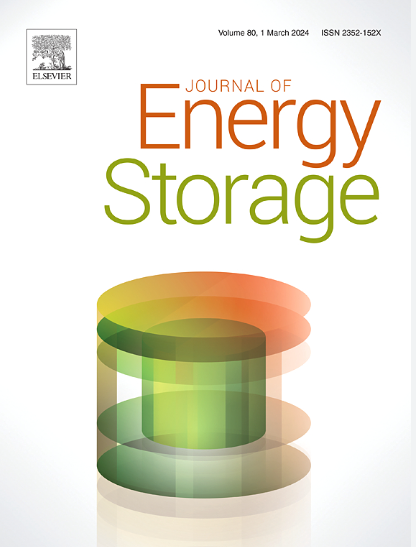ZnFe2O4 nanoparticles decorated MoS2 nanosheets for high-performance supercapacitors
IF 8.9
2区 工程技术
Q1 ENERGY & FUELS
引用次数: 0
Abstract
This study presents a significant advancement in electrochemical energy storage by designing and synthesizing MoS2/ZnFe2O4 Nanocomposites (NCs) with exceptional electrochemical properties. The NCs were synthesized using a hydrothermal process, combining MoS2 Nanosheets (NS) with ZnFe2O4 Nanoparticles (NPs). This design leverages the synergistic benefits of both materials, resulting in superior capacitive performance compared to previous reports. The optimized 1:1 molar ratio of MoS2/ZnFe2O4 NC demonstrated a specific capacitance of 2076.9 F/g at 25 A/g and retained 94.3 % of its capacitance after 2500 cycles. The MoS2 NS acts as a substrate to prevent ZnFe2O4 NP agglomeration, while the ZnFe2O4 NPs inhibit MoS2 NS restacking. Density functional theory (DFT) calculations reveal that the MoS2/ZnFe2O4 interface introduces new energy states near the Fermi level, boosting the heterostructure's capacitance. With their enhanced electrochemical performance, these NCs show great potential for diverse advanced energy storage and conversion systems.

纳米ZnFe2O4修饰MoS2纳米片用于高性能超级电容器
本研究通过设计和合成具有优异电化学性能的MoS2/ZnFe2O4纳米复合材料(NCs),在电化学储能方面取得了重大进展。采用水热法将MoS2纳米片(NS)与ZnFe2O4纳米片(NPs)结合,合成了纳米片。这种设计利用了两种材料的协同效益,与以前的报告相比,产生了卓越的电容性能。优化后的MoS2/ZnFe2O4 NC的摩尔比为1:1,在25 a /g下的比电容为2076.9 F/g,循环2500次后电容保持率为94.3%。MoS2 NS作为衬底阻止ZnFe2O4 NP团聚,而ZnFe2O4 NPs则抑制MoS2 NS团聚。密度泛函理论(DFT)计算表明,MoS2/ZnFe2O4界面在费米能级附近引入了新的能态,提高了异质结构的电容。由于其电化学性能的提高,这些纳米材料在各种先进的能量存储和转换系统中显示出巨大的潜力。
本文章由计算机程序翻译,如有差异,请以英文原文为准。
求助全文
约1分钟内获得全文
求助全文
来源期刊

Journal of energy storage
Energy-Renewable Energy, Sustainability and the Environment
CiteScore
11.80
自引率
24.50%
发文量
2262
审稿时长
69 days
期刊介绍:
Journal of energy storage focusses on all aspects of energy storage, in particular systems integration, electric grid integration, modelling and analysis, novel energy storage technologies, sizing and management strategies, business models for operation of storage systems and energy storage developments worldwide.
 求助内容:
求助内容: 应助结果提醒方式:
应助结果提醒方式:


